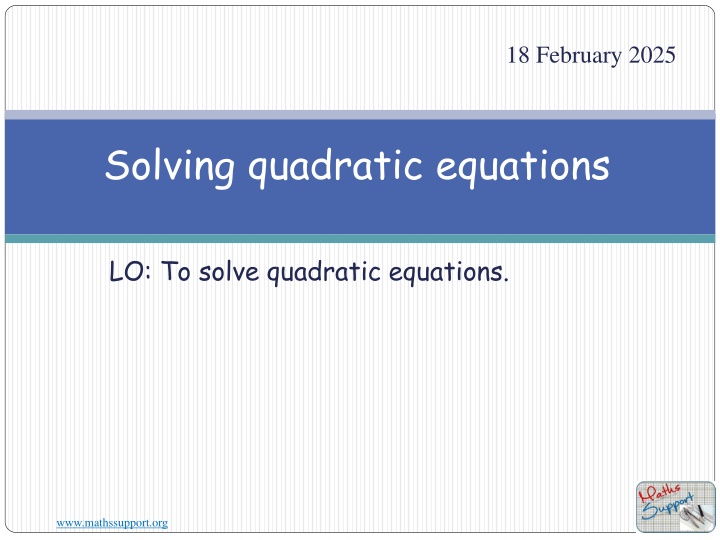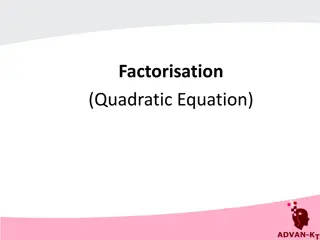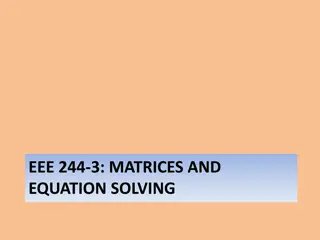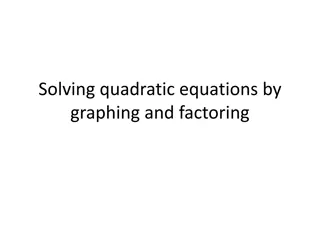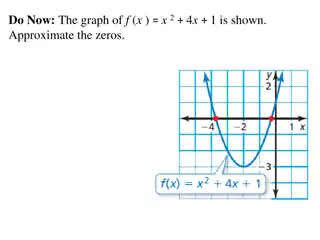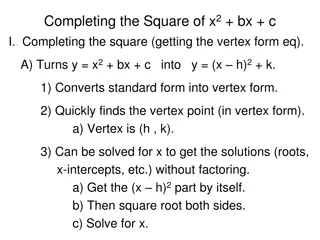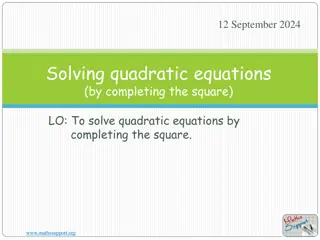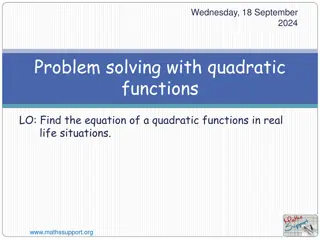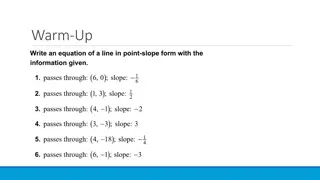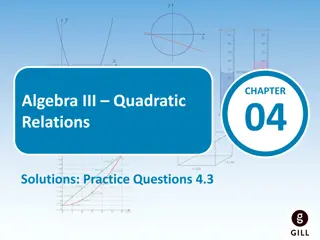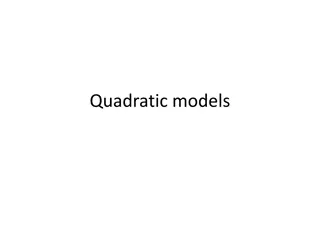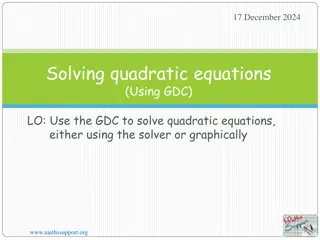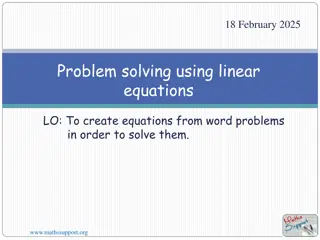Solving quadratic equations
Quadratic equations are solved by finding the values of x that satisfy the equation ax^2 + bx + c = 0. This post covers the general form of quadratic equations, examples, and step-by-step solutions for equations like x( x + 4) = 0 or ( x - 5)^2 = 0. Learn how to rearrange equations for solving and understand the concepts behind finding solutions to quadratic equations.
Download Presentation

Please find below an Image/Link to download the presentation.
The content on the website is provided AS IS for your information and personal use only. It may not be sold, licensed, or shared on other websites without obtaining consent from the author.If you encounter any issues during the download, it is possible that the publisher has removed the file from their server.
You are allowed to download the files provided on this website for personal or commercial use, subject to the condition that they are used lawfully. All files are the property of their respective owners.
The content on the website is provided AS IS for your information and personal use only. It may not be sold, licensed, or shared on other websites without obtaining consent from the author.
E N D
Presentation Transcript
18 February 2025 Solving quadratic equations LO: To solve quadratic equations. www.mathssupport.org www.mathssupport.org
Quadratic equations The general form of a quadratic equation is ax2 + bx + c = 0 Wherea, bandcare constants and a 0. Is called the quadratic term ax2 Is called the linear term bx Is called the constant term c Ifb 0 andc 0. www.mathssupport.org www.mathssupport.org
Quadratic equations ax2 + bx + c = 0 Examples of quadratic equations b = - 3 c = -4 a = 1 x2 3x 4 = 0 x2 3x 4 = 0 2x2 50 = 0 2x2 = 50 b = 0 c = -50 a = 2 b = 7 c = -12 a = 3 3x2 = 12 7x 3x2 + 7x 12 = 0 b = -2 c = 0 a = 5 5x2 = 2x 5x2 2x = 0 a = -35 b = 15 c = 0 35x2 + 15x = 0 5x(3 7x) = 0 (x 6)(2 4x) = 12x a = -4 b = 14 c = -12 4x2 + 14x 12 = 0 Some of these equations are not in the form ax2 + bx + c = 0 But they can be rearranged into this form www.mathssupport.org www.mathssupport.org
Quadratic equations Solve the equation x (x+ 4) = 0 When two numbers multiply together to make 0, one of the numbers must be 0, (or both are 0) so if x (x+ 4) = 0 we can conclude that either or x = 0 x + 4 = 0 x = -4 This gives us two solutions that solve the quadratic equation: x = 0 and x = -4 Page 249, Exercise 103 Questions 1 - 9 www.mathssupport.org www.mathssupport.org
Quadratic equations Solve the equation (x- 5)2 = 0 (x- 5)2 = 0 is the same as (x - 5)(x - 5) = 0 we can conclude that either or x - 5 = 0 x = 5 x - 5 = 0 x = 5 and There is only one solution that solve the quadratic equation: www.mathssupport.org www.mathssupport.org
Quadratic equations Solve the equation (x + 2)(x+ 3) = 0 When two numbers multiply together to make 0, one of the numbers must be 0, (or both are 0) so if (x+ 2)(x+ 3) = 0 we can conclude that either or x + 2 = 0 x = 2 x + 3 = 0 x = -3 and This gives us two solutions that solve the quadratic equation: www.mathssupport.org www.mathssupport.org
Solving Quadratic equations ax2 + bx + c = 0 ax2 + bx + c = 0 (x + p)(x + q) = 0 x = -p x = -q or Where p x q = c and p + q = b If c is positive then p and q have the same signs as b If c is negative then p and q have opposite signs to each other www.mathssupport.org www.mathssupport.org
Solving Quadratic equations We can solve the quadratic equationx2 + 4x 45 = 0 in full by factorizing the expression on the left-hand side. This means that we can write the equation in the form (x + p)(x + q) = 0 We need to find two integers that add together (p + q) equals 4 and multiply together (pq) equals 45. Because 45 is negative, one of the numbers must be positive and one must be negative. By considering the factors of 45 we find that the two numbers must be 9 and 5. We can therefore write x2 + 4x 45 = 0 as (x + 9)(x 5) = 0 www.mathssupport.org www.mathssupport.org
Solving Quadratic equations When two numbers multiply together to make 0, one of the numbers must be 0, (null factor law), so if (x + 9)(x 5) = 0 we can conclude that either or x + 9 = 0 x 5 = 0 This gives us two solutions that solve the quadratic equation: and x = 9 x = 5 www.mathssupport.org www.mathssupport.org
Solving quadratic equations by factorization Solve the equation x2 + 5x + 6= 0 Start by factorising the equation We need to find two integers that add together to make 5 and multiply together to make 6. Because 4 is positive and 6 is positive, both the integers must be positive. These are 3 and 2. Factorizing the left-hand side gives us (x + 3)(x + 2)= 0 x + 3 = 0 x = -3 or x + 2 = 0 x = -2 www.mathssupport.org www.mathssupport.org
Solving quadratic equations by factorization Solve the equation x2 5x = 4 by factorization. Start by rearranging the equation equating to zero, so that all the terms are on the left-hand side. x2 5x + 4 = 0 We need to find two integers that add together to make 5 and multiply together to make 4. Because 4 is positive and 5 is negative, both the integers must be negative. These are 1 and 4. Factorizing the left-hand side gives us (x 1)(x 4)= 0 x 1 = 0 or x 4 = 0 x = 1 x = 4 www.mathssupport.org www.mathssupport.org
Solving quadratic equations by factorization Solve the equation x2 2x 8 = 0 by factorization. x = 2 x = 4 or Solve the equation x2 10x + 21 = 0 by factorization. x = 3 x = 7 or Solve the equation x2 5x 6 = 0 by factorization. x = 1 x = 6 or Solve the equation x2 5x + 6 = 0 by factorization. x = 2 x = 3 or www.mathssupport.org www.mathssupport.org
Solving quadratic equations by factorization ?? Solve the equation 6x2 11x + 3 = 0 by factorization. 11 To factorise the left hand side we split the middle term To split the middle term we multiply the first an last coefficients. Now we find two numbers whose product is +18 and add up to -11. The two numbers are 9 and 2 because ( 9)( 2) =+18 and 9 2 = 11 6?2 = 0 Splitting the middle term 9? 2?+3 11? 1 2? 3 = 0 3? 2? 3 Remove the common factor from each group 3? 1 2? 3 = 0 3? 1 = 0 3? = 1 ? =? ? Set each factor equal to zero 2? 3 = 0 2? = 3 Solving for x ? =? ? www.mathssupport.org www.mathssupport.org
Solving quadratic equations by factorization ?? Solve the equation 5x2 33x 14 = 0 by factorization. 33 To split the middle term we multiply the first an last coefficients. Now we find two numbers whose product is -70 and add up to -33. The two numbers are 35 and2 because ( 35)(2) =-70 and 35 + 2 = 33 5?2 35?+2? 14 33? 5? ? 7 +2 ? 7 = 0 Splitting the middle term Remove the common factor from each group = 0 5? + 2 ? 7 = 0 5? + 2 = 0 3? = 1 Set each factor equal to zero ? 7 = 0 Solving for x ? = 7 ? =? ? www.mathssupport.org www.mathssupport.org
Thank you for using resources from A close up of a cage Description automatically generated For more resources visit our website https://www.mathssupport.org If you have a special request, drop us an email info@mathssupport.org www.mathssupport.org www.mathssupport.org
